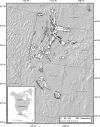Ungulate Reproductive Parameters Track Satellite Observations of Plant Phenology across Latitude and Climatological Regimes
- PMID: 26849642
- PMCID: PMC4744036
- DOI: 10.1371/journal.pone.0148780
Ungulate Reproductive Parameters Track Satellite Observations of Plant Phenology across Latitude and Climatological Regimes
Abstract
The effect of climatically-driven plant phenology on mammalian reproduction is one key to predicting species-specific demographic responses to climate change. Large ungulates face their greatest energetic demands from the later stages of pregnancy through weaning, and so in seasonal environments parturition dates should match periods of high primary productivity. Interannual variation in weather influences the quality and timing of forage availability, which can influence neonatal survival. Here, we evaluated macro-scale patterns in reproductive performance of a widely distributed ungulate (mule deer, Odocoileus hemionus) across contrasting climatological regimes using satellite-derived indices of primary productivity and plant phenology over eight degrees of latitude (890 km) in the American Southwest. The dataset comprised > 180,000 animal observations taken from 54 populations over eight years (2004-2011). Regionally, both the start and peak of growing season ("Start" and "Peak", respectively) are negatively and significantly correlated with latitude, an unusual pattern stemming from a change in the dominance of spring snowmelt in the north to the influence of the North American Monsoon in the south. Corresponding to the timing and variation in both the Start and Peak, mule deer reproduction was latest, lowest, and most variable at lower latitudes where plant phenology is timed to the onset of monsoonal moisture. Parturition dates closely tracked the growing season across space, lagging behind the Start and preceding the Peak by 27 and 23 days, respectively. Mean juvenile production increased, and variation decreased, with increasing latitude. Temporally, juvenile production was best predicted by primary productivity during summer, which encompassed late pregnancy, parturition, and early lactation. Our findings offer a parsimonious explanation of two key reproductive parameters in ungulate demography, timing of parturition and mean annual production, across latitude and changing climatological regimes. Practically, this demonstrates the potential for broad-scale modeling of couplings between climate, plant phenology, and animal populations using space-borne observations.
Conflict of interest statement
Figures






Similar articles
-
Asynchronous vegetation phenology enhances winter body condition of a large mobile herbivore.Oecologia. 2015 Oct;179(2):377-91. doi: 10.1007/s00442-015-3348-9. Epub 2015 May 26. Oecologia. 2015. PMID: 26009244
-
Distance, weather, and forage conditions drive timing of autumn migration in female mule deer.Mov Ecol. 2025 Feb 25;13(1):10. doi: 10.1186/s40462-025-00540-x. Mov Ecol. 2025. PMID: 40001255 Free PMC article.
-
Do mule deer surf peaks in forage quality while on summer range?Ecology. 2025 Apr;106(4):e70068. doi: 10.1002/ecy.70068. Ecology. 2025. PMID: 40259626
-
Mismatch between birth date and vegetation phenology slows the demography of roe deer.PLoS Biol. 2014 Apr 1;12(4):e1001828. doi: 10.1371/journal.pbio.1001828. eCollection 2014 Apr. PLoS Biol. 2014. PMID: 24690936 Free PMC article.
-
Advancing the match-mismatch framework for large herbivores in the Arctic: Evaluating the evidence for a trophic mismatch in caribou.PLoS One. 2017 Feb 23;12(2):e0171807. doi: 10.1371/journal.pone.0171807. eCollection 2017. PLoS One. 2017. PMID: 28231256 Free PMC article.
Cited by
-
A fine-scale examination of parturition timing in temperate ungulates.Ecol Evol. 2024 Jul 3;14(7):e11703. doi: 10.1002/ece3.11703. eCollection 2024 Jul. Ecol Evol. 2024. PMID: 38962024 Free PMC article.
-
Ecological effects of fear: How spatiotemporal heterogeneity in predation risk influences mule deer access to forage in a sky-island system.Ecol Evol. 2019 Jun 2;9(12):7213-7226. doi: 10.1002/ece3.5291. eCollection 2019 Jun. Ecol Evol. 2019. PMID: 31380044 Free PMC article.
-
Birth date determines early calf survival in migratory caribou.Oecologia. 2023 Aug;202(4):819-830. doi: 10.1007/s00442-023-05441-7. Epub 2023 Aug 28. Oecologia. 2023. PMID: 37640888
-
Establishing reproductive seasons for the conservation of the critically endangered Kashmir red deer Cervus Hanglu.Sci Rep. 2025 Feb 10;15(1):4955. doi: 10.1038/s41598-025-89244-1. Sci Rep. 2025. PMID: 39930058 Free PMC article.
-
Coursing hyenas and stalking lions: The potential for inter- and intraspecific interactions.PLoS One. 2023 Feb 3;18(2):e0265054. doi: 10.1371/journal.pone.0265054. eCollection 2023. PLoS One. 2023. PMID: 36735747 Free PMC article.
References
-
- Loe LE, Bonefant C, Mysterud A, Gaillard J-M, Langvatn R, Kleins F, et al. Climate predictability and breeding phenology in red deer: timing and synchrony of rutting and calving in Norway and France. Journal of Animal Ecology. 2005; 74:579–588.
-
- Kerby J, Post E. Reproductive phenology of large mammals In: Schwartz MD, editor. Phenology: an integrative environmental science, Second Edition Dordrecht, Netherlands: Springer; 2013. p. 467–479.
-
- Ogutu JO, Piepho HP, Dublin HT. Responses of phenology, synchrony, and fecundity of breeding by African ungulates to interannual variation in rainfall. Wildlife Research 2013; 40:698–717.
-
- Schwartz MD. Introduction In: Schwartz MD, editor. Phenology: an integrative environmental science, Second Edition Dordrecht, Netherlands: Springer; 2013. p. 1–5.
Publication types
MeSH terms
LinkOut - more resources
Full Text Sources
Other Literature Sources
Medical

